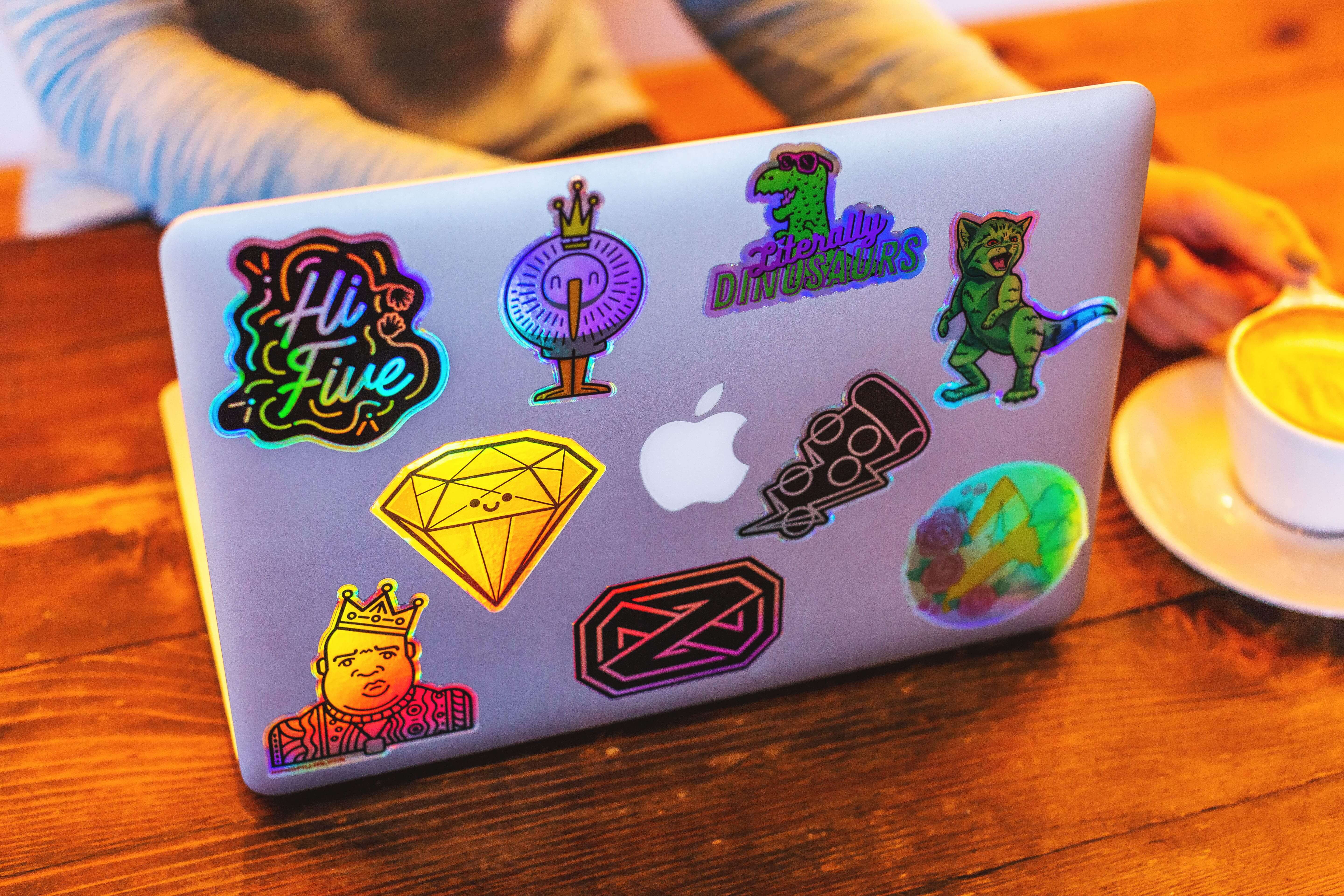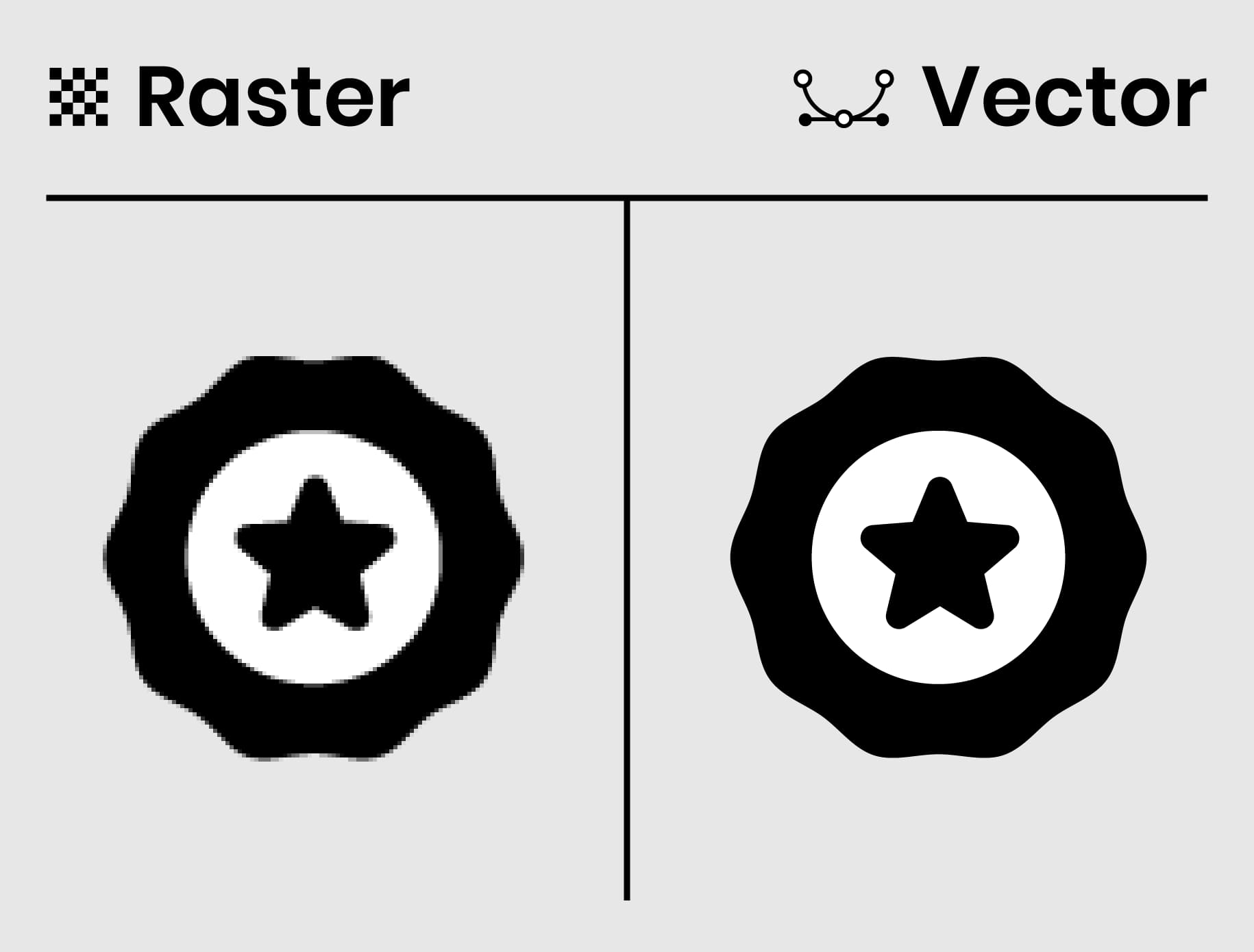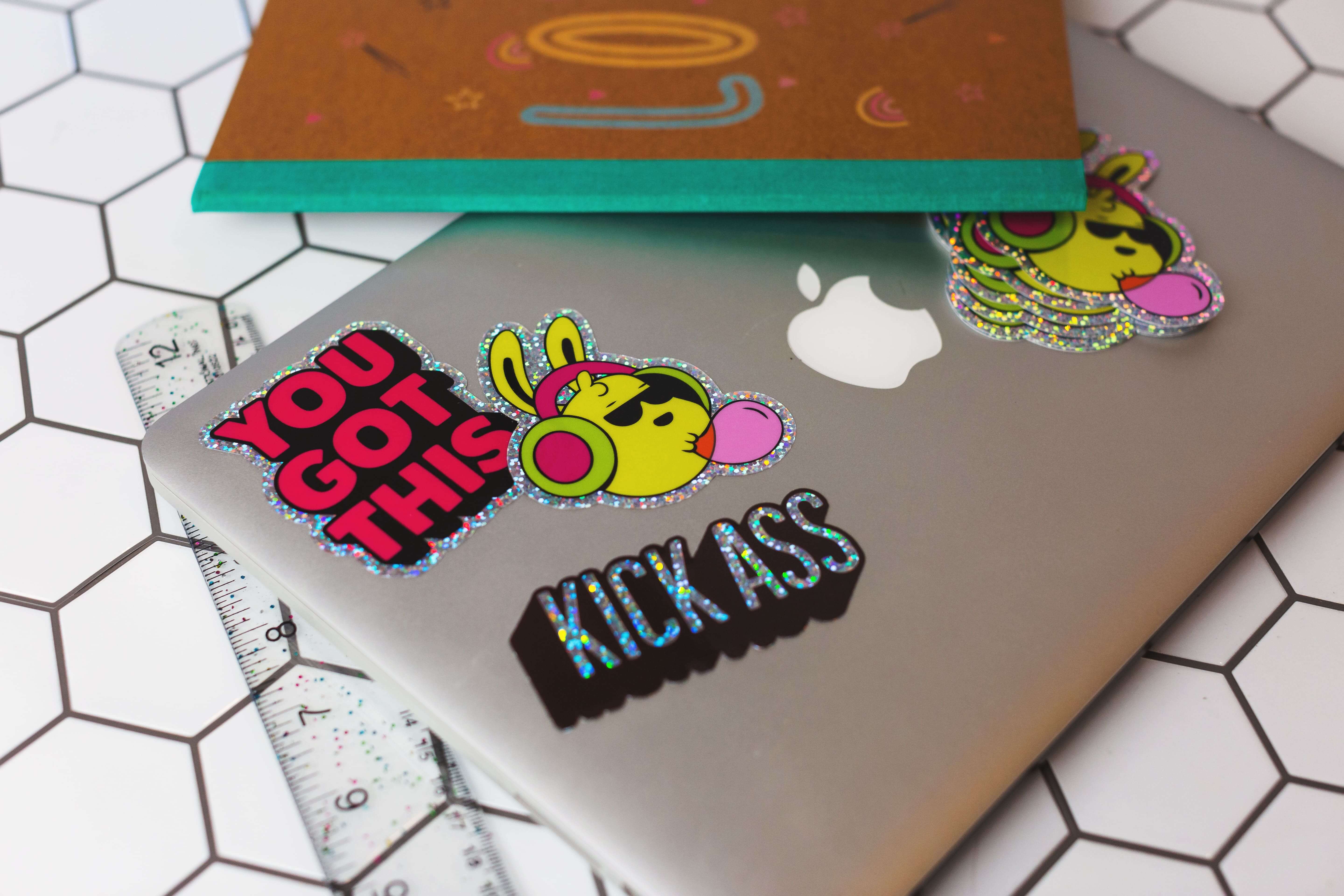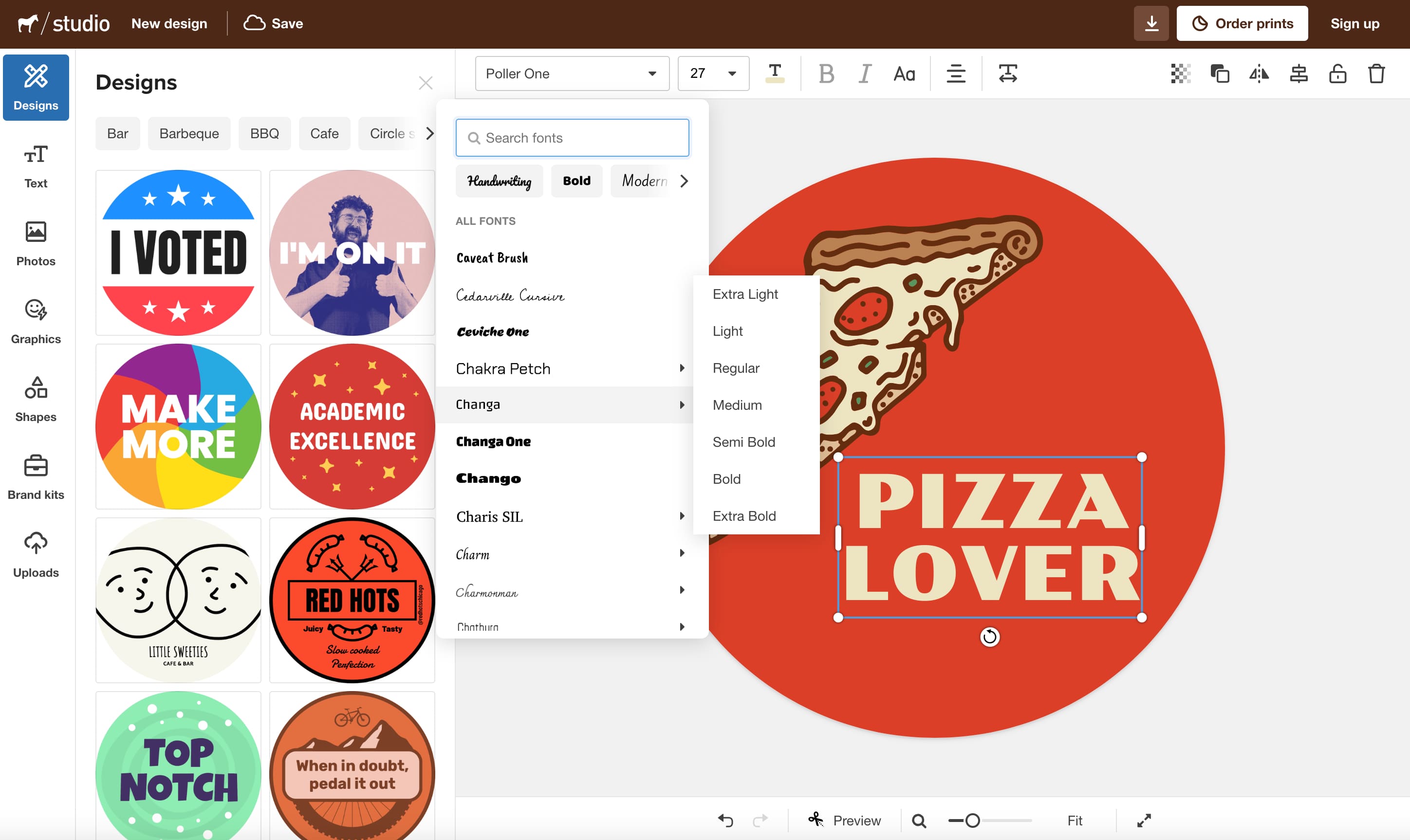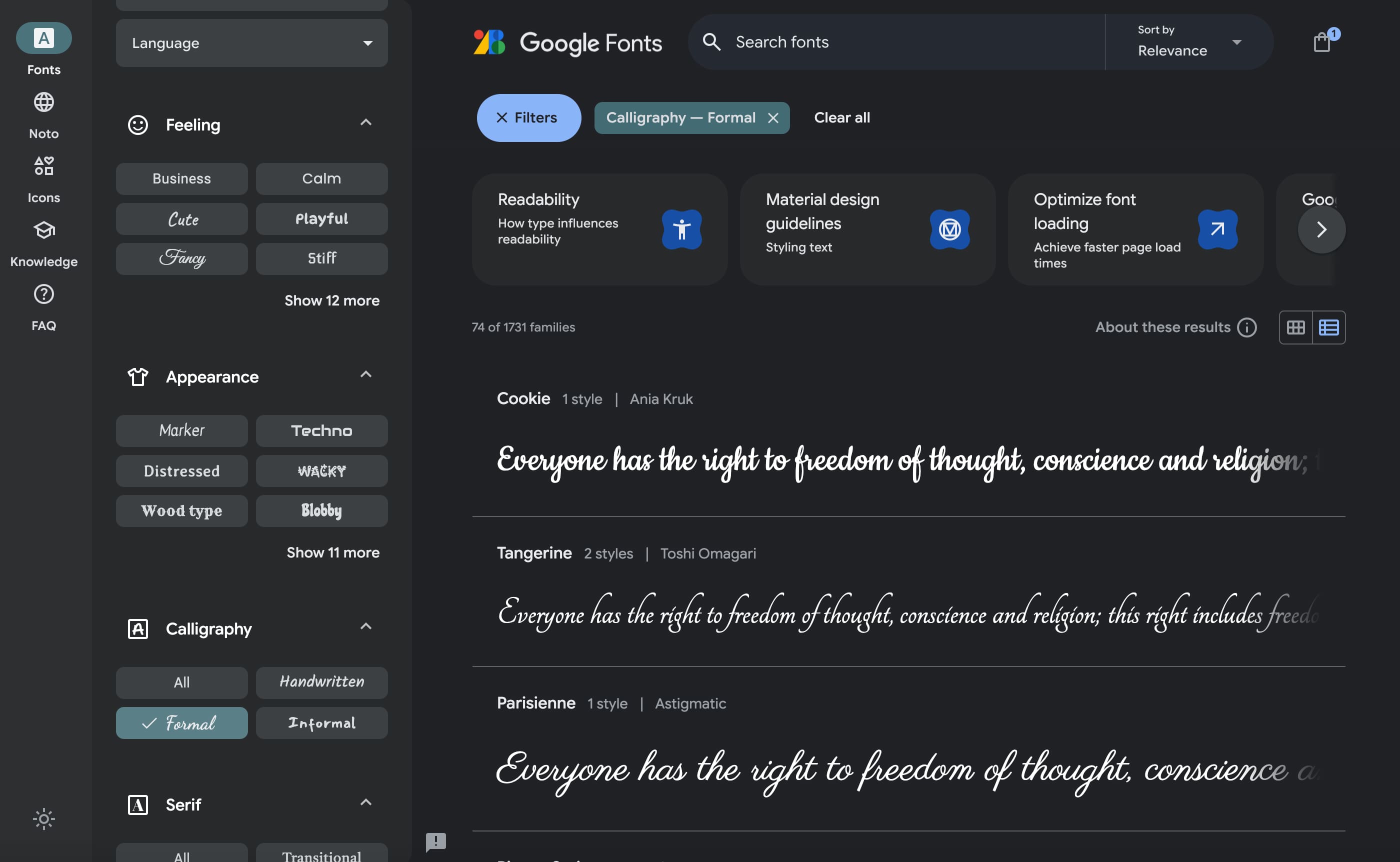So entwerfen Sie Sticker: Sticker selbst gestalten, Teil 1
Von Sticker Mule am gepostet
Individuelle Sticker sind nicht nur amüsant, sie sind auch ein wirkungsvolles Werbe- und Markenbildungsmittel. Sogar die Monetarisierung gelingt mit ihnen einfacher. Egal, ob Sie als Kleinunternehmer die Markewiedererkennung steigern, oder als Designer neue Entwürfe für den Vertrieb erstellen möchten: Für den perfekten Sticker braucht es mehr als nur ein gewisses Maß an technischem Knowhow.
Sorgfältige Entscheidungen während der Design- und Vorbereitungsphase sind entscheidend, um sicherzustellen, dass Ihre Sticker nicht nur großartig aussehen, sondern auch bei Ihrem Zielpublikum gut ankommen. Ob die Sticker für Ihre eigene Rockband, oder für die 6. Geburtstagsparty Ihrer Nichte gedacht sind, die Designentscheidungen werden wahrscheinlich nicht dieselben sein.
Um professionelle Ergebnisse erzielen zu können, ist ein Verständnis der Nuancen des Stickerdrucks unentbehrlich. Beispielsweise kann die Wahl zwischen konturgeschnittenen Aufklebern mit ihren individuell geformten Designs und angestanzten Stickern mit einer flexiblen, abziehbaren Rückseite sowohl das Aussehen als auch die Funktionalität Ihrer Sticker stark beeinflussen.
In dieser Anleitung führen wir Sie durch den gesamten Vorgang vom Entwurf Ihrer Sticker über die Vorbereitung Ihrer Dateien bis hin zur Auswahl der geeigneten Druckoptionen. Mit diesen Tipps ausgerüstet, steht dem Entwurf wahrhaftig auffallender Sticker nichts mehr im Wege.
Ohne Umschweife: So gestalten Sie Ihre individuellen Sticker – der gesamte Vorgang von A bis Z.
1. Ideensuche
Ganz an Anfang des Designvorgangs steht immer die Überlegung: Für wen sind Ihre Sticker gedacht und welche Botschaft möchten Sie mit ihnen vermitteln. Ein tolles Design ist nicht nur optisch ansprechend – es muss auch bei Ihrer Zielgruppe gut ankommen.
Welche Zielgruppe möchten Sie ansprechen?
Beliebte Sticker sprechen oft ein gemeinsames Interesse, eine Emotion oder einen Trend an. Lustige, farbenfrohe Sticker mit niedlichen Figuren könnten beispielsweise ein jüngeres Publikum ansprechen, während schlichte, minimalistische Designs besser zu Berufstätigen passen, die sie auf ihren Laptop kleben und in ihrem Lieblingscafé zur Schau zu stellen möchten.
Lernen Sie Ihre Zielgruppe kennen, um so Ihre Designentscheidungen besser steuern zu können. Das Ergebnis ist ein durchdachtes, maßgeschneidertes Design, das bei den Empfängern Anklang findet.
Inspirationssuche
Bei der Online-Ideensuche sind Plattformen wie Pinterest und Instagram hervorragende Ausgangspunkte. Entdecken Sie trendige Designs und notieren Sie, was Ihnen ins Auge fällt.
Insbesondere mit Pinterest gelingt die Suche nach ansprechenden Stilen und in Beziehung stehenden Bildern anhand bestimmter Ästhetiken oder Schlüsselwörtern. Das Erstellen eines Boards für jedes Projekt ist eine großartige Möglichkeit, organisiert zu bleiben und Ihre Inspiration an einem Ort zu sammeln.
Es versteht sich von selbst, dass man andere nicht eins zu eins kopieren sollte. Sich von verschiedenen Designs inspirieren zu lassen und mit Kombinationen verschiedener Konzepte zu spielen, ist großartig. Jedoch gibt es eine Grenze zwischen der Inspirationssuche durch die Designs anderer und dem Diebstahl derer Arbeit. Sie möchten sich nicht dem Zorn der 6-Jährigen stellen müssen, deren Zeichnung eines Einhorns Sie "ausgeliehen" haben – und dem von ihr angeheuertem Team von Rechtsanwälten für geistiges Eigentum.
Spaß beiseite, Kopieren ist nicht cool. Bleiben Sie kreativ und authentisch.
Zögern Sie in dieser Phase nicht, sich Notizen zu machen oder ein paar grobe Ideen zu skizzieren. Eine visuelle Referenz kann Ihnen später bei Ihren Designentscheidungen helfen. Wenn Sie erst einmal in die richtige Stimmung kommen, fließen die kreativen Säfte schnell.
2. Von der Idee zur Skizze
Jetzt, da Ihnen weitere Ideen einfallen, ist es an der Zeit, diese während der Arbeit aufs Papier (oder auf den Bildschirm) zu übertragen.
Obwohl die Magie beim Entwerfen eines Stickers letztendlich digital passiert, empfiehlt es sich dennoch, mit einem Blatt Papier zu starten. Eine kleine Skizze braucht nur wenige Sekunden und ist viel natürlicher. Sie ermöglicht ein taktiles Erlebnis, ungefilterte Kreativität und die Möglichkeit, sich zu konzentrieren und Ihre Fähigkeiten ohne die Einschränkungen der Technologie zu verfeinern.
Wenn alles nebeneinander steht, können auch leichter Verbindungen/Überschneidungen hergestellt werden, und meistens entstehen dadurch die originellsten Ideen.
In einem solchen Designvorgang gibt es grundsätzlich zwei verschiedene Arten des Skizzierens:
Grobe Skizze
- Bei dieser Art des Skizzierens geht es darum, Ihre Ideen aufs Papier zu bringen. Wahrscheinlich wird es eine Mischung aus Worten und Zeichnungen sein, aber die Qualität der Zeichnungen spielt keine Rolle – wichtig ist, Ihre Gedanken festzuhalten. Nachdem Sie ein Brainstorming durchgeführt und eine Reihe von Ideen skizziert haben, wählen Sie einige aus, die Potenzial zeigen, um sie weiterzuerforschen. Die Länge dieser Phase hängt davon ab, wie viel Zeit Sie investieren möchten.
- Wenn diese eine Erfolgsidee auftaucht, ist sie oft so aufregend, dass man es kaum erwarten kann, sie weiterzuentwickeln. Das sind die besten Momente als Designer. Versuchen Sie, für jedes Projekt die herausragende Idee zu finden – die, mit der Sie es kaum erwarten können, loszulegen. Es ist jedoch immer eine gute Idee, ein paar zusätzliche Skizzen in Reserve zu halten. Wählen Sie also unbedingt auch ein paar Ersatzideen aus.
Verfeinerte Skizze
- Sobald Sie einige vielversprechende Ideen gefunden haben, ist es an der Zeit, diese weiter zu verfeinern. Lassen Sie Strichmännchen und schnelle Kritzeleien hinter sich und beginnen Sie, den Charakter zu definieren, den Sie erstellen möchten, und die Typografie, die Sie sich vorstellen – es sei denn natürlich, Strichmännchen und gekritzelte Wörter sind genau die Optik, die Sie anstreben!
- In dieser Phase können Sie bei Stift und Papier bleiben oder auf ein digitales Medium, das mehr Flexibilität bietet, umsteigen. Viele Designer verwenden heute Tools wie ein iPad mit Skizziersoftware wie Procreate, die ein natürliches Zeichenerlebnis bietet und die Vorteile von Funktionen wie "Rückgängig" und einem Radiergummi bietet. Leider gibt es im echten Leben immer noch keine "Rückgängig"-Funktion (Elon Musk hat den Chat betreten).

3. Von Skizze zu Bildschirm
Sobald Ihre Skizze fertig ist und Sie eine klare Vorstellung davon haben, wie sie am Ende aussehen soll, ist es an der Zeit, sie auf den Bildschirm zu bringen. Wenn Sie etwas entwerfen, das irgendwann gedruckt werden muss, müssen Sie einige Grundlagen beachten, um ein optimales Ergebnis zu erzielen.
Raster- vs. Vektorgrafiken
Um die bestmögliche Druckqualität zu erzielen, ist die Verwendung von Vektorgrafiken ein Muss. Vektordateien wie AI und EPS sind skalierbar, ohne dabei ihre Auflösung zu verlieren, wodurch sie sich perfekt für den Stickerdruck eignen. Rasterbilder (wie PNG und JPEG) können bei Größenänderungen verpixeln, daher sollten diese am besten vermieden werden, insbesondere bei großen Stickern.
Wir haben den Unterschied zwischen Raster- und Vektorgrafiken in einem früheren Artikel bereits erklärt.
Tools wie Adobe Illustrator oder anfängerfreundliche Plattformen wie Studio von Sticker Mule können Ihnen dabei helfen, Ihre Skizze in ein ausgefeiltes Design zu verwandeln.
Bei einer Wahl zwischen Adobe Illustrator und Adobe Photoshop sollten Sie sich immer für Illustrator entscheiden. Obwohl viele Leute Photoshop für Designzwecke verwenden, ist es in erster Linie ein Fotobearbeitungstool und weist Einschränkungen bei der Erstellung detaillierter Designs auf.
Für Sticker wird die Verwendung von Vektordateien empfohlen, ist aber nicht zwingend erforderlich. Solange Ihr Design eine Auflösung von 300 DPI oder höher aufweist, sollte es keine Schwierigkeiten geben.
Die richtige Größe wählen
Die Größe der Sticker hängt vom jeweiligen Verwendungszweck ab. Für einfachere Sticker wie Logos eignet sich eine kleinere Größe wie 76 mm x 76 mm gut. Dekorativere Sticker benötigen möglicherweise mehr Platz, um komplizierte Details hervorzuheben. Berücksichtigen Sie bei der Auswahl der Abmessungen immer den Verwendungszweck Ihres Stickers und stellen Sie sich vor, wie die Größe im gedruckten Zustand im wirklichen Leben aussehen wird. Die beliebtesten Anwendungen sind Laptops, Wasserflaschen, Autos, Handys sowie Notizbücher und Planer.
Beginnen Sie damit, Ihr Design mit einem Lineal auf Papier zu skizzieren, um die ideale Größe zu ermitteln. Sie können es zwar später immer noch anpassen, aber wenn Sie mit einer guten Annäherung beginnen, sparen Sie Zeit. Wenn Sie zu Hause einen Drucker haben, können Sie einen Probedruck durchführen, um die perfekte Größe zu ermitteln. Alternativ können Sie Lineale auf dem Bildschirm verwenden, um die genauen Abmessungen direkt auf Ihrem Computer zu bestimmen. Dies ist besonders praktisch, wenn Sie unterwegs sind und kein Papier oder Lineal parat haben.
4. Designgrundlagen
Sticker mögen zwar klein sein, aber ein effektives Design macht sie zum Hingucker. Von Farbe über Typografie und Balance bis hin zur visuellen Hierarchie – das Verständnis dieser Grundlagen hilft Ihnen beim Entwurf von Stickern, die nicht nur optisch beeindrucken, sondern auch Ihre Botschaft klar vermitteln.
Nun wollen wir einige dieser Designgrundlagen etwas detaillierter durchgehen.
Farbe
Farben sind mehr als nur ein visuelles Element – sie vermitteln Emotionen. Die Wahl der richtigen Farbpalette für Ihre Sticker ist entscheidend, um die Identität Ihrer Marke, Ihren persönlichen Stil und die Botschaft, die Sie kommunizieren möchten, zu vermitteln.
So gehen Sie die Farbgestaltung Ihrer Sticker an:
Farbpsychologie verstehen
- Verschiedene Farben rufen unterschiedliche Emotionen hervor. Beispielsweise vermittelt Blau Vertrauen und Professionalität und eignet sich daher ideal für geschäftsorientierte Designs. Gelb und Orange wecken Aufregung und Energie und sprechen ein jüngeres, verspielteres Publikum an. Überlegen Sie, wie Ihre Farbauswahl mit den Emotionen und Werten Ihrer Zielgruppe übereinstimmt.
Kontrastierende Farben verwenden
- Ein hoher Farbkontrast sorgt für ein hervorstechendes Design. Besonders bei kleineren Designs wie Stickern ist dieser Aspekt wichtig. Dunkler Text auf hellem Hintergrund oder komplementäre Farbpaare wie Blau und Orange können Lesbarkeit verbessern und visuelle Wirkung erzielen. Verwenden Sie Tools wie Coolors oder Adobe Colors, um Farbpaletten auszuwählen und zu bearbeiten.
Marke im Blick behalten
- Wenn Sie Sticker für eine Marke erstellen, achten Sie darauf, dass Sie sich an die Farbpalette Ihrer Marke halten. Konsistenz stärkt die Markenwiedererkennung, insbesondere für Werbe- oder Marketingzwecke.
Druckfarbmodi berücksichtigen
- Während beim digitalen Design häufig RGB (Rot, Grün, Blau) verwendet wird, ist beim Drucken CMYK (Cyan, Magenta, Gelb, Schwarz) für eine genaue Farbwiedergabe erforderlich. Konvertieren Sie Ihr Design vor dem Drucken in CMYK, um sicherzustellen, dass Ihre Farben wie beabsichtigt angezeigt werden.

Einige Farben, hauptsächlich helle, können im Druck ganz anders als erwartet ausfallen. Wir erhalten Ihr RGB-Farbprofil, um eine bessere Farbübereinstimmung zu erzielen als bei der Konvertierung in CMYK selbst. Jedoch empfehlen wir Ihnen, Ihr Design in CMYK exportiert einzureichen, um möglichen ungewünschten Überraschungen vorzubeugen.
Es stehen Ihnen einige Tools zur automatischen Konvertierung zur Verfügung, aber werfen Sie vor dem Exportieren Ihrer Datei immer einen zweiten kritischen Blick darauf.
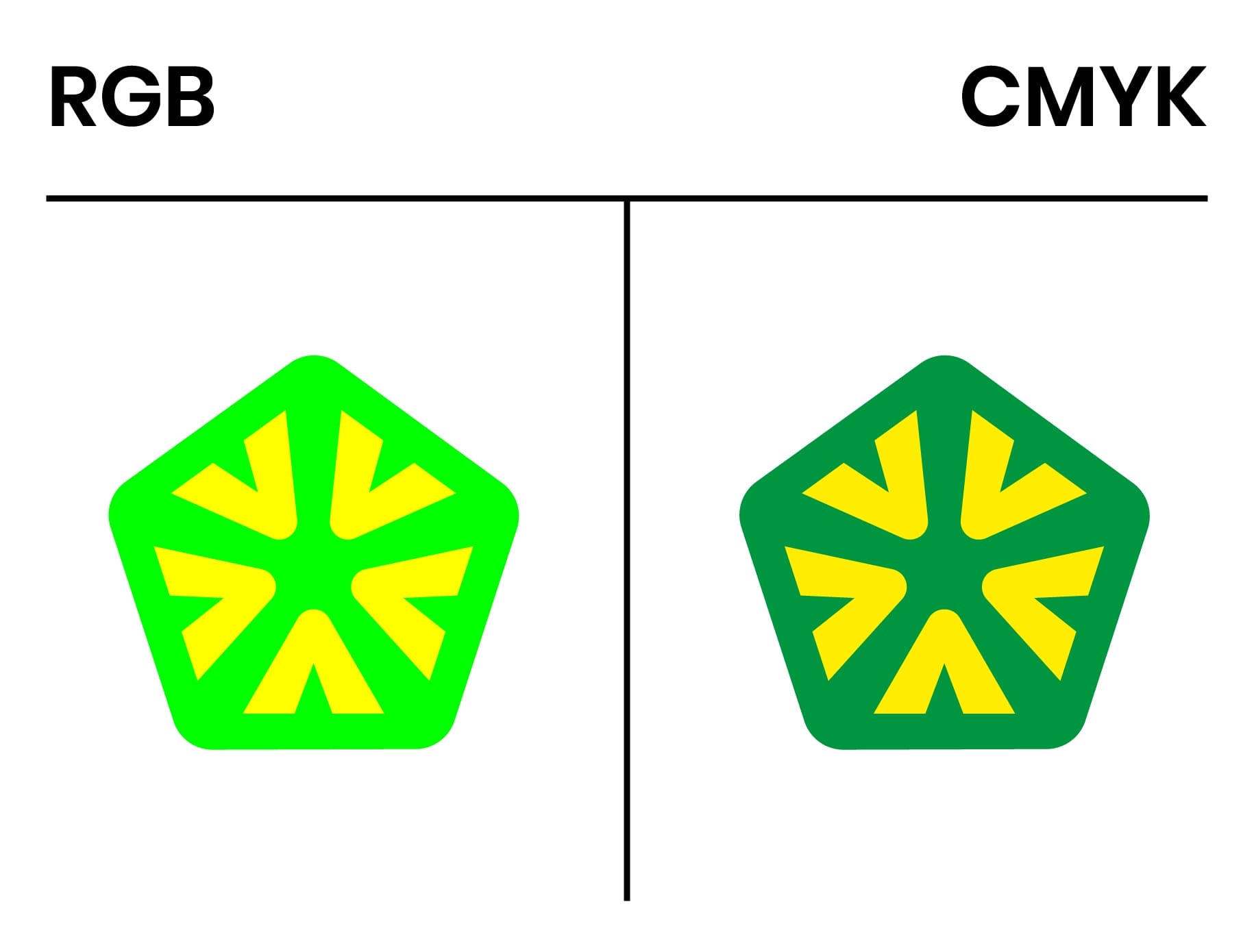
Typografie
Text spielt bei vielen Stickerdesigns eine entscheidende Rolle, egal ob Sie einen einprägsamen Werbespruch, einen Markennamen oder einfach nur die URL einer Website einfügen möchten. Typografie kann Ihrem Sticker zwar Persönlichkeit und Flair verleihen, aber die Lesbarkeit muss immer oberste Priorität behalten.
- Schriftartenauswahl
- Online-Plattformen wie Adobe Fonts, DaFont, Google Fonts und Font Squirrel bieten kostenlose Schriftarten, die Sie für kommerzielle Projekte verwenden können. Filtern Sie nach der gesuchten Schriftart, und die perfekte Übereinstimmung wird sich schon bald blicken lassen. Wenn Sie nach kostenpflichtigen Schriftarten suchen, ist MyFonts derzeit die beliebteste Option.
In unserem kostenlosen Tool Studio können Sie aus Hunderten von kostenlosen Schriftarten wählen, sodass die perfekte Übereinstimmung immer gleich um die Ecke auf Sie wartet.
Schriftartenpaarung
- Scheuen Sie sich nicht davor, Schriftarten zu paaren, aber achten Sie immer darauf, dass diese sich gegenseitig ergänzen. Die Verwendung einer Schriftart für Ihre Hauptbotschaft und einer anderen für einen Werbespruch kann dabei helfen, eine visuelle Hierarchie zu etablieren und den Blick des Betrachters auf die wichtigsten Elemente des Designs zu lenken. Eine gute Faustregel ist, eine fette, dekorative Schriftart mit einer einfacheren serifenlosen oder Serifenschrift zu kombinieren. Machen Sie den Unterschied zwischen den Schriftarten jedoch nicht zu subtil, sonst wirkt das Ganze zu chaotisch und unbeabsichtigt.
- Größe und Maßstab
- Da Sticker oft klein sind, muss Ihr Text auf den ersten Blick lesbar sein. Verwenden Sie für Text, der hervorstechen soll, einfache, fette Schriftarten. Vermeiden Sie übermäßig komplizierte oder dünne Schriftarten, die bei Verkleinerung unlesbar werden können. Versuchen Sie, beim Gestalten herauszuzoomen oder ein paar Meter von Ihrem Bildschirm wegzutreten. So bekommen Sie einen besseren Eindruck zur Optik Ihres Designs bei verschiedenen Größen.
Persönlichkeit durch Schriftarten ausdrücken
- Ihre Auswahl der Typografie sollte auch den Ton Ihres Stickers widerspiegeln. Beispielsweise eignen sich verspielte, handgeschriebene Schriftarten gut für einen Sticker mit einer lässigen, lustigen Ausstrahlung, während eine klare, geometrische Schriftart besser zu einer professionellen oder modernen Ästhetik passt. Wir möchten bei Stickern allzu offensichtliche Designentscheidungen vermeiden, aber manchmal lohnt es sich doch, das Design klar und einfach zu halten.
Die meisten kostenlosen Schriftartenplattformen wie Google Fonts bieten Ihnen die Möglichkeit, nach bestimmten Werten wie Schriftsystemen, Sprachen, Anzahl der Stile und, am wichtigsten, der Art der Schriftart zu filtern.
Weißraum
Weniger kann auch manchmal mehr sein. Weißraum bezieht sich auf die leeren Bereiche in Ihrem Design (die nicht unbedingt weiß sein müssen). Weißraum ist keine Platzverschwendung, sondern ein unentbehrliches Designelement, welches das Erscheinungsbild Ihres Stickers erheblich aufzuwerten vermag.
- Verbesserung der Lesbarkeit
- Weißraum hilft, Elemente in Ihrem Design voneinander zu trennen, sodass der Betrachter die Informationen leichter verarbeiten kann. Bei textlastigen Designs sorgt ausreichend Platz um Buchstaben und Wörter herum für Klarheit und Lesbarkeit auf den ersten Blick.
-Fokus schaffen - Indem Sie genügend Weißraum um Ihre Hauptelemente herum lassen, können diese Elemente atmen und in den Mittelpunkt rücken. Dies ist besonders effektiv bei minimalistischen Stickern oder Designs, bei denen ein Element wie Ihr Logo oder Ihr Werbespruch im Mittelpunkt stehen soll.
Komplexität und Einfachheit ausbalancieren – Scheuen Sie sich nicht davor, bestimmte Bereiche Ihres Stickers leer zu lassen. Wenn Sie das Design mit zu vielen Details überladen, kann es überfüllt und schwer lesbar wirken. Konzentrieren Sie sich stattdessen auf ein oder zwei Schlüsselelemente und nutzen Sie Weißraum, um ihnen Atemraum zu verschaffen.
Balance und Zusammensetzung
Ein ausgewogenes Design wirkt stabil, übersichtlich und optisch ansprechend. Beim Stickerdesign ist die Harmonie zwischen Text, Grafik und Logo entscheidend für ein ansprechendes Endprodukt.
Symmetrie vs. Asymmetrie
- Symmetrische Designs wirken eher formell und ausgeglichen, während asymmetrische Designs dynamische Bewegung und Interesse erzeugen können. Beides hat seine Vorzüge, je nachdem, welche Stimmung Sie vermitteln möchten. Jedoch ist es wichtig, die Elemente bewusst in Ihr Design zu setzen.
Visuelles Gewicht
- Berücksichtigen Sie das visuelle Gewicht jedes Elements in Ihrem Design. Größere, auffälligere Elemente ziehen natürlich mehr Aufmerksamkeit auf sich, während kleinere oder leichtere Elemente in den Hintergrund treten können. Indem Sie diese Elemente ausbalancieren, können Sie das Auge des Betrachters im Wesentlichen in der beabsichtigten Reihenfolge durch das Design führen.
Ausrichtung und Fluss
- Eine gute Ausrichtung verleiht Ihrem Design ein Gefühl von Ordnung und Professionalität. Egal, ob Sie den Text zentrieren, links oder rechts ausrichten, die Konsistenz ist entscheidend. Denken Sie außerdem darüber nach, wie sich die Blicke des Betrachters durch den Sticker bewegen. Starten Sie bei der Hauptbotschaft und wenden Sie die Blicke dann zu den Details. Stellen Sie sicher, dass Ihre Komposition diese Reise effektiv leitet, und testen Sie das Ergebnis natürlich auch selbst.
Kontrast und visuelle Hierarchie
Kontrast bezieht sich nicht nur auf verwendete Farben – er gilt auch für Größe, Form und Typografie. Indem Sie in Ihrem Design Kontrast erzeugen, schaffen Sie eine klare visuelle Hierarchie und lenken den Blick des Betrachters auf die wichtigsten Elemente.
Dies ist besonders wichtig für Sticker, die oft aus der Ferne oder im Vorbeigehen gesehen werden, wie z. B. auf Autostoßstangen oder auf Laptops. Ein starker Kontrast sorgt dafür, dass Ihr Design Aufmerksamkeit erregt und auch auf den ersten Blick effektiv kommuniziert.
Größenkontrast
- Machen Sie die wichtigsten Elemente Ihres Designs größer, um sie hervorzuheben. Beispielsweise sollte Ihr Markenname oder Werbespruch deutlicher hervortreten als zweitrangige Details wie eine Website-URL oder ein Untertitel.
Schriftstärke und -stil
- Fette, dickere Schriftarten ziehen natürlich mehr Aufmerksamkeit auf sich als dünnere. Nutzen Sie dies zu Ihrem Vorteil, indem Sie Ihre Kernbotschaft oder Überschrift fett drucken, während der unterstützende Text kleiner oder dünner ausfallen darf.
Form und Gestalt
- Auch mit Kontrasten in Form und Gestalt lässt sich Interesse wecken. Wenn Sie beispielsweise eine kräftige, geometrische Form mit einer eher organischen, frei gestalteten Grafik kombinieren, entsteht dabei oft ein ansprechender visueller Kontrast, der die Aufmerksamkeit auf sich zieht.
Stickerform
Die Form Ihrer Sticker spielt eine wichtige Rolle fürs Gesamtdesign und seine Verwendbarkeit. Die meisten Vinyl Sticker fallen in diese Kategorien: gestanzte Sticker (auch konturgeschnittene Aufkleber genannt) und angestanzte Sticker. Wenn Sie vom Konzept zum Druck übergehen, ist es wichtig zu verstehen, wie sich diese Stickerarten auf das Design auswirken.
- Gestanzte Sticker
- Gestanzte Sticker werden auf die exakte Form des Designs zugeschnitten, egal ob es sich um eine benutzerdefinierte Form, einen Standardkreis oder ein Quadrat handelt. Achten Sie beim Design gestanzter Sticker darauf, dass alle Elemente innerhalb der Schnittlinien bleiben. Die Form sollte das Design hervorheben und nicht davon ablenken. Beispielsweise sieht ein Logo mit scharfen Kanten möglicherweise besser aus, wenn es genau auf seine Konturen gestanzt wird, anstatt auf einen Standardkreis gedruckt zu werden.
- Angestanzte Sticker
- Angestanzte Sticker sind Sticker, die präzise durch die oberste Materialschicht (den Sticker selbst) zugeschnitten werden, ohne dabei das Trägerpapier zu durchtrennen. Dadurch bleibt das Trägerpapier intakt, bietet zusätzlichen Halt und ermöglicht ein einfaches Abziehen der Sticker. Bei angestanzten Stickern hat das Trägerpapier oft eine größere Oberfläche als der Sticker selbst. Dadurch bietet sich weiterer Platz für Markenzeichen, Anweisungen oder zusätzliche Designelemente. Diese Sticker eignen sich für komplizierte Designs, da der Schneidevorgang nur die Stickerschicht betrifft und das Trägerpapier unversehrt und erhalten bleibt.
- Transfer Sticker
- Farbige Transfer Sticker sind eine großartige Option für Designs, die keinen farbigen Hintergrund benötigen. Anders als bei herkömmlichen Stickern befinden sich die einzelnen Elemente des Designs auf einem Transferblatt, womit eine saubere, nahtlose Anwendung ermöglicht wird. Alle Teile werden auf einmal aufgetragen, wodurch eine polierte, professionelle Optik entsteht.
Skalierung
Es ist wichtig, die Skalierung Ihres Designs zu berücksichtigen, insbesondere wenn es in mehreren Größen oder auf verschiedenen Produkten wie T-Shirts oder Magneten angeboten werden soll. Ein Design, das in einem 127 mm x 127 mm Maßstab großartig aussieht, kann bei einer Verkleinerung auf 51 mm x 51 mm an Details oder Lesbarkeit verlieren.
Verschiedene Größen testen
- Um eine zufriedenstellende Optik und Lesbarkeit sicherzustellen, sollten Sie Ihr Design immer in verschiedenen Größen ausprobieren. Elemente wie komplizierte Illustrationen, feine Details und kleiner Text müssen für kleinere Sticker möglicherweise vereinfacht werden.
Vektorgrafiken für Skalierbarkeit verwenden
- Wie bereits erwähnt, stellt das Erstellen Ihres Stickers in einem Vektorformat sicher, dass er ohne Qualitätsverlust vergrößert oder verkleinert werden kann. Vektorgrafiken sind auflösungsunabhängig und daher ideal für den Druck von Stickern jeder Größe geeignet. Dasselbe Design eines 51×51-mm-Stickers könnte ohne Qualitätsverlust in eine großformatige Plakatwand verwandelt werden. Reine Magie.
Indem Sie sich auf die Designgrundlagen: Farbe, Typografie, Weißraum, Balance, Kontrast und Skalierbarkeit konzentrieren, werden Ihre Stickerdesigns nicht nur optisch ansprechend aussehen, sondern auch ihren Zweck effektiv erfüllen – egal ob für den persönlichen Gebrauch, den Markenaufbau oder für Werbezwecke gedacht.
Der Schlüssel liegt darin, Ihre Zielgruppe im Auge zu behalten und diese Leitsätze sorgfältig anzuwenden, damit Ihr Design wirklich ins Auge fällt.
In Teil 2 ist die Rede davon, wie Sie Ihre Designs produzieren lassen.
